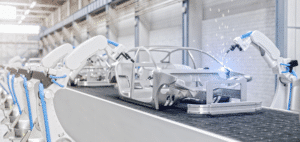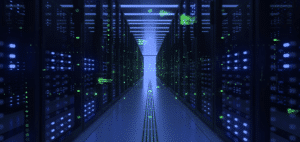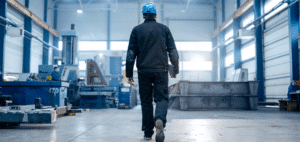AI and robotics are taking the world by storm, with up-and-coming technologies taking off and revolutionizing how companies in virtually every industry function, including manufacturing. Robotic technology has been used in manufacturing for decades. Still, with new AI developments, these robots have become even more advanced, capable of responding to human input and even learning independently based on these inputs. This development creates several new possibilities for every part of production within manufacturing.
With over four decades of expertise in the light industrial staffing industry, Doherty Staffing Solutions has established itself as a trusted authority, catering to the diverse needs of businesses and job seekers alike. We are committed to keeping up to date with the latest technological industry developments so that we can continue providing key insights and customized staffing solutions that meet the needs of an evolving industry. The fast-paced development of AI and AI-backed robotics will undeniably impact the light industrial and manufacturing industries, but how soon will these changes begin to take place, and what might the use of AI and AI robotics look like in your company? In this article, we will explore the emergence of Industry 4.0, the current adoption rate of high-tech processes in the manufacturing industry, and the pros and cons of AI and robotic technology so that you can make an informed decision about how large of a role, if any, you would like these tools to play in your organization moving forward.
Industry 4.0 and Current Adoption
The fourth industrial revolution is on the horizon, which has been coined Industry 4.0, the emergence of “smart” technology within interconnected production systems. An integral piece of this revolution is “smart factories.” IBM defines smart factories as factories that “are equipped with advanced sensors, embedded software, and robotics that collect and analyze data and allow for better decision making.” These smart factories may help decision makers by providing valuable data in areas of the supply chain, ERP, customer service, and more. These technologies could benefit manufacturers from the top down, but complete integration of this high-tech model is still few and far between.
The lack of adoption of these high-tech solutions is mainly due to three primary reasons, with one of the key components being that reluctance still exists to trust a machine over a human. This pushback is present across many industries, but when it comes to the light industrial industry specifically, many people wonder if a machine could replace the expertise of a well-versed professional or would rather account for human error than make such a significant and costly transition. Additionally, there still needs to be more transparency around what AI would be used for and the belief that these advancements are intended to replace humans entirely. Similarly, because the idea of what AI and AI robotics could look like is so muddy, digitalizing factories is not a high priority for companies. Processes for integrating and adopting a “smart factory” model are not commonplace, and the adoption can be highly costly upfront, which must be weighed against the significant ROI.
Currently, only a small number of companies in the United States have implemented these technologies in manufacturing. However, a Deloitte study found that 93 percent of companies believe AI will be a pivotal technology to drive growth and innovation in the sector, which likely will drive company investment in integrating AI technology in the coming years. China is a current leader in AI technology in manufacturing, with favorable infrastructure to explore these advancements. Despite being the market leader in AI robotics, the same Deloitte survey found that 91% of the projects that have taken place so far have not met expectations. This relatively new market still has a long way to go, but as the implementation of AI technology continues to gain traction in the industry, it is important to weigh the pros and cons.
Pros
There are many potential benefits to the integration of AI and AI robotics technology. One of these benefits is the scalability of these technologies. One of the common problems within the industry is the need for more knowledge or visibility when it comes to the ebbs and flows of production demands. This lack of transparency can result in staffing issues, missed deadlines, inability to meet demand, and supply chain issues, resulting in upset customers and even potential loss of business. The application of AI can be monumental when forecasting supply chain demands, with a McKinsey study revealing that AI technology can reduce error rates in demand forecasting by up to 50 percent. Granted, AI cannot always predict with total accuracy; however, having access to the data that AI can provide can save organizations significant costs by helping key decision makers gain better insight into demand fluctuations.
As with many technologies, AI robots can make processes more efficient and productive. This perk is twofold, with increased efficiency for repetitive processes typical of your run-of-the-mill robot, but also the increased efficiency of the AI component; new technologies allow robots to learn independently and generate their own designs. This autonomous learning process is called deep learning, where the “artificial neural network” of these machines can recognize objects independently without engineers needing to input new 3D models like traditional machines. Deep learning improves over time as machines learn continuously, and they can even communicate with each other through data stored on the cloud. This makes factories more efficient, saving the time it would take to input new data and associated costs. Additionally, generative AI can be used to create production-level designs to be reviewed by engineers, which helps to save time in the design process. Due to deep learning, generative AI will also improve with continued use.
As mentioned, AI can significantly reduce human error, resulting in better quality control. Aside from automating repetitive tasks, AI robots can also identify defects that a human could miss down to a microscopic level, which could improve the detection of errors by a whopping 90 percent. This process is also backed by deep learning, where data of a quality product versus a defective product are entered into robotic technology that can identify slight differences between products.
With the promise that deep learning technology provides, it makes sense that there is concern about the displacement of human workers. However, these technologies will still need to be monitored and maintained, creating engineering, cybersecurity, maintenance, and programming jobs. This provides an opportunity for workers to upskill and learn new things related to these machines, which will be in high demand as there are few experts in both manufacturing and AI technology. Technological maintenance skills will be highly transferable for repairing these machines and AI robots. Even though robots can work 24/7 without getting tired or bored, unlike humans, that does not mean that humans will not still need to be a part of the process.
Lastly, these technologies can be used for dangerous jobs or jobs that are undesirable to humans. A recent report from the National Safety Council found that using autonomous mobile robots (AMRs) could reduce workplace fatality rates that have been stagnant for over 30 years. The application of these robots would be especially useful when handling hazardous, flammable materials or in high-heat environments. Additional applications include work in confined spaces, mines, or high-risk construction environments. Of course, exposure to hazardous work environments can never be entirely eliminated because accidents will always happen, but using robots instead of humans in highly hazardous environments can surely help to reduce these accidents from occurring.
Cons
Although there are significant reasons for manufacturing companies to start exploring AI applications in their factories, there are also downsides that should be considered before, during, and after implementing these advancements. The first of these is the high upfront cost of AI technology. This causes a considerable barrier, especially for smaller companies and startups, as the cost associated with AI and AI robots, especially those capable of deep learning, makes them generally inaccessible. Not only do companies need to purchase the software, but they also need to purchase cloud storage space on servers, and there is also the cost associated with the labor of hiring experts in the area, such as data scientists, software engineers, and developers, which require much higher annual salaries than a general laborer would.
Hiring AI experts is not only costly but due to AI in manufacturing being a new market, they are also hard to come by. Companies may be able to find professionals well-versed in AI but not in manufacturing or vice versa. Especially presently, organizations will likely have a hard time finding a candidate that is an expert in both manufacturing and AI and may have to resort to training internally on missing skills, which consumes company time and resources that could be better used elsewhere. It is important to note that this downside will likely improve in coming years as there is more demand for these kinds of professionals, but presently, this is a very prevalent issue.
One of the more apparent cons of AI and AI robotics in manufacturing environments is the loss of the human element and the subsequent loss of human jobs. There are many tasks that a robot cannot do that a human can, and in the manufacturing industry, a lot of these tasks fall into the category of fine-tuned adjustments. Robots have difficulty following instructions that are not cut and dry, such as “arrange these items evenly” or “distribute in an organized fashion.” Similarly, tasks that are nuanced or handle a wide variety of products and parts will be complicated to replace with AI. Another piece of the human element that is hard to replace is creativity. Generative AI has limits based on initial input and human ingenuity, so brainstorming can be difficult to replicate successfully, especially at this stage of development.
Even though there are things that AI cannot do, and AI still needs to be monitored by humans, there is no denying that some workers will be displaced with the growth of these technologies. A McKinsey report found that by 2030, 400 million workers could be displaced due to AI technology. In the pros section, we covered that these technologies could create more skilled jobs and create an opportunity for companies to train displaced workers, but there is no guarantee that this will come to fruition.
Lastly, with technology comes cybersecurity risks. A cyberattack could be disastrous for the bottom line if a company relies heavily on AI technology to keep up with production demands. As these technologies become more prevalent, so will the risk of hackers. In fact, the manufacturing industry in 2022 was already the largest sector for cyberattacks, putting AI-powered factories at even greater risk than other industries. Cybersecurity will need to be top of mind for organizations, and they will need to invest heavily in protection from potential breaches.
Looking to the Future
As we look to the future, companies across every industry must weigh the pros and cons of AI. Prioritizing employees will remain an important part of AI integration, and the concern around the potential displacement of workers should be addressed with poise as an organization begins to integrate these technologies.
Regardless of what individual companies decide, Industry 4.0 is an exciting part of history to be involved in, and it will undoubtedly create a number of changes in the manufacturing industry in the coming years. Whether you want to join a light industrial team during this exciting time or find the right talent to support your organization, don’t hesitate to contact Doherty Staffing Solutions and get started today!




